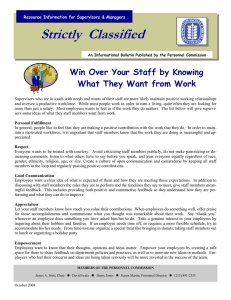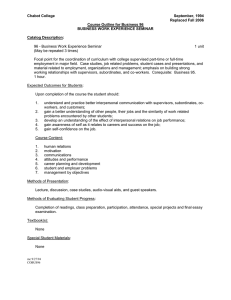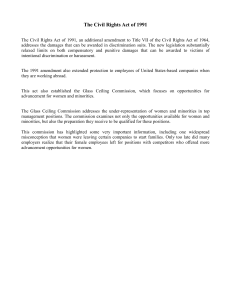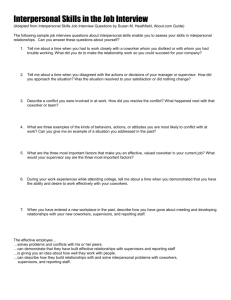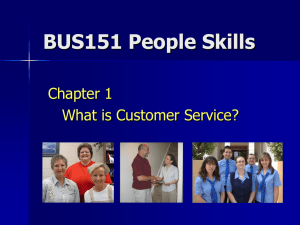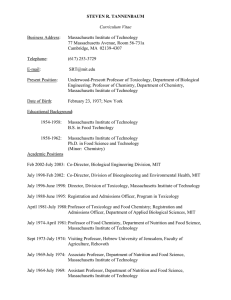Learning Systems Dr. Steve Training & Development INP6325
advertisement
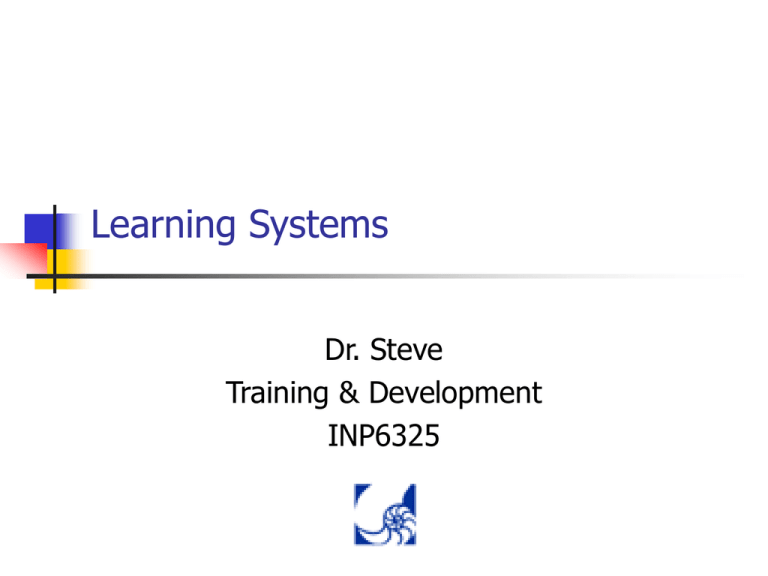
Learning Systems Dr. Steve Training & Development INP6325 Learning Organizations Importance of learning to success of organizations Kapp (1999): the only sustainable advantage an organization will have in the future is its ability to learn faster than its competitors Rousseau (1997): To survive and thrive firms will need to learn at an increasingly rapid rate Learning Environment Survey (Tannenbaum, 1997) Is your organization a learning organization? My organization typically: Provides people with opportunities to learn new things Assigns people to positions to stretch them Tolerates mistakes when someone is first learning a new task or skill Views new problems and work challenges as opportunities to develop people’s skills Monitors to see that people continue to develop and learn throughout their career Expects everyone, not just mgt, to solve problems and offer solutions Provides paid release time for employee development purposes Rewards employees for using what they have learned in training on their job Learning Environment Survey (Tannenbaum, 1997) What is the organizational climate conducive for training In my organization: Supervisors and co-workers help reschedule work so that employees can attend training Supervisors provide constructive feedback when someone tries something new on the job Supervisors offer people opportunities to use new skills they learned in training Training is considered an important part of career development The successful people go to training It is acceptable to question others about why things are done a certain way Learning Organizations Models for becoming a learning organization 1. Building internal capability 2. Focus on total quality 3. Training the trainer Pay for knowledge work system Providing a vision Decentralized decision making Continuous improvement Corporate universities Train employees consistent with organizational values Train technical and interpersonal skills Corporate Universities Corporate Universities – promote continuous learning in an organization by: 1. 2. 3. 4. Building competency-based training curriculum Providing employees with shared vision and values of company Extending training to customers and suppliers Serving as a learning laboratory for experimenting with new approaches McDonald’s Hamburger University • Oak Brook, Illinois • Founded in 1961 • Avg class of 200 • 65,000 mgrs graduated • 30 professors Training and Societal Concerns How training impacts societal problems Increase readiness of individuals entering workforce Enhance fair employment practices once individuals enter the workforce Ex: training at-risk youth, literacy programs, WAGES Ex: training to comply with ADA, provide minority opportunities for advancement Retrain individuals to maintain current employment or prepare them for other jobs Ex: re-train displace factory workers, train computer skills Workforce Readiness Problem 27 million functionally illiterate Americans 21% of adult population has only rudimentary reading/writing skills Disproportionately large number of minorities are illiterate H.S. dropouts 28% unemployment rate, diploma still not enough Training solutions Programs aimed at developing not only technical job-specific skills, but also basic work skills (e.g., interpersonal skills, reliability, punctuality) Ex: Worker Training and Assistance Program (WTAP): Orientation Workplace skills Transition skills Managerial skills School-to-Work Transition Secretary’s (of Labor) Commission on Achieving Necessary Skills (SCANS) identified 5 sets of competencies necessary to keep and hold a job 1. Resources: Identifies, organizes, plans, and allocates resources 2. Interpersonal: Works with others 3. Information: Acquires and uses information 4. Systems: Understands complex interrelationships 5. Technology: Works with a variety of technologies Training and Equal Opportunity Relevant Laws Civil Rights Act of 1964, Title VII – It is illegal for employers to discriminate on the basis of race, color, religion, sex, or national original. Americans with Disabilities Act (ADA) of 1990 – It is illegal to discriminate in employment against a qualified individual with a disability. Those with a disability must be provided a reasonable accommodation. Age Discrimination in Employment Act (ADEA) – Protects workers age 40 and over from discrimination in employment. Training and Equal Opportunity Equal Opportunity Legal Issues for Training Training as a job prerequisite Training performance as criterion for another job Receipt of training as basis for advancement or raise Training and Equal Opportunity Glass ceiling – invisible barrier preventing women and minorities from ascending to top managerial positions Training must be equally available to women and minorities so that they may succeed and advance Training and Equal Opportunity Disabled Workers – disabled workers must receive reasonable accommodations, which may include additional training may need to provide training to those who work with the disabled Training and Equal Opportunity Retraining Older Workers – Older workers may become unemployed due obsolescence of job skills or layoffs. May need additional training to compete with younger individuals who received recently updated training Orgs may provide outplacement services including training, counseling, and other services to aid job search. Other Societal Issues and Training Terrorism How will training be used to fight terrorism? Different type of military training Training civilians how to recognize warning signs Training for airline industry (e.g., baggage inspectors to be more vigilant, flight attendants in self-defense) Training cultural diversity and tolerance to prevent backlash of bigotry, harassment, and discrimination Training medical health specialists to identify symptoms related to chemical/biological attacks Emergency crowd egress training
